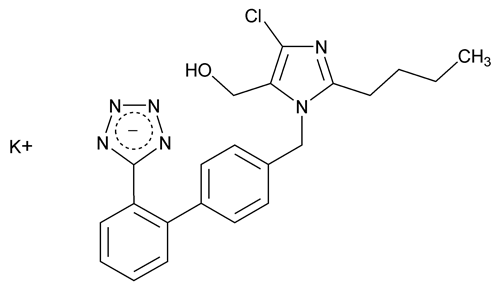Losartan Potassium
(loe sar' tan poe tas' ee um).
1H-Imidazole-5-methanol, 2-butyl-4-chloro-1-[[2¢-(lH-tetrazol-5-yl)[1,1¢-biphenyl]-4-yl]methyl]-, monopotassium salt.
2-Butyl-4-chloro-1-[p-(o-lH-tetrazol-5-ylphenyl)benzyl] imidazole-5-methanol, monopotassium salt
» Losartan Potassium contains not less than 98.5 percent and not more than 101.0 percent of C22H22ClKN6O calculated on the anhydrous, solvent-free basis.
Packaging and storage—
Preserve in well-closed containers. Store at controlled room temperature.
Identification—
C:
It meets the requirements of the test for Potassium  191
191 .
.
Water, Method I  921
921  :
not more than 0.5%.
:
not more than 0.5%.
Heavy metals, Method II  231
231 :
0.001%.
:
0.001%.
Chromatographic purity—
Solution A—
Prepare a 0.1% solution of phosphoric acid in water.
Solution B—
Use acetonitrile.
Mobile phase—
Use variable mixtures of Solution A and Solution B as directed for Chromatographic system. Make adjustments if necessary (see System Suitability under Chromatography  621
621 .
.
System suitability solution—
Dissolve an accurately weighed quantity of USP Losartan Potassium RS and triphenylmethanol in methanol, and dilute quantitatively, and stepwise if necessary, to obtain a solution having known concentrations of about 0.3 mg per mL and 0.002 mg per mL, respectively.
Test solution—
Transfer about 30 mg of Losartan Potassium, accurately weighed, to a 100-mL volumetric flask, dissolve in and dilute with methanol to volume, and mix.
Chromatographic system (see Chromatography  621
621 )—
The liquid chromatograph is equipped with a 220-nm detector and a 4.0-mm × 25-cm column containing packing L1. The flow rate is about l mL per minute. The chromatograph is programmed as follows.
)—
The liquid chromatograph is equipped with a 220-nm detector and a 4.0-mm × 25-cm column containing packing L1. The flow rate is about l mL per minute. The chromatograph is programmed as follows.
Chromatograph the System suitability solution, and record the peak responses as directed for Procedure: the relative retention times are about 1.0 for losartan and 1.9 for triphenylmethanol; and the tailing factor for losartan is not more than 1.6. [note—The typical retention time for triphenylmethanol is about 20 minutes. ]
| Time (minutes) |
Solution A
(%) |
Solution B
(%) |
Elution |
|---|---|---|---|
| 0 | 75 | 25 | equilibration |
| 0–25 | 75®10 | 25®90 | linear gradient |
| 25–35 | 10 | 90 | isocratic |
| 35–45 | 10®75 | 90®25 | linear gradient |
| 45–50 | 75 | 25 | re-equilibration |
Procedure—
Inject a volume (about 10 µL) of the Test solution into the chromatograph, record the chromatogram, and measure all the peak responses. Calculate the percentage of each impurity in the portion of Losartan Potassium taken by the formula:
100(ri / rs)
in which ri is the peak response for each impurity; and rs is the sum of the responses for all the peaks: not more than 0.2% of any individual impurity is found; and not more than 0.5% of total impurities is found.
Assay—
Solution A and Solution B—
Proceed as directed in the test for Chromatographic purity.
Mobile phase—
Prepare a filtered and degassed mixture of Solution A and Solution B (3:2). Make adjustments if necessary (see System Suitability under Chromatography  621
621 ).
).
Standard preparation—
Dissolve an accurately weighed quantity of USP Losartan Potassium RS in methanol, and dilute quantitatively, and stepwise if necessary, to obtain a solution having a known concentration of about 0.25 mg per mL.
Assay preparation—
Transfer about 25 mg of Losartan Potassium, accurately weighed, to a 100-mL volumetric flask, dissolve in and dilute with methanol to volume, and mix.
Chromatographic system (see Chromatography  621
621 )—
The liquid chromatograph is equipped with a 254-nm detector and a 4.0-mm × 25-cm column that contains packing L1. The flow rate is about 1.0 mL per minute. The column temperature is maintained at about 35
)—
The liquid chromatograph is equipped with a 254-nm detector and a 4.0-mm × 25-cm column that contains packing L1. The flow rate is about 1.0 mL per minute. The column temperature is maintained at about 35 . Chromatograph the Standard preparation, and record the peak responses as directed for Procedure: the column efficiency is not less than 5600 theoretical plates; the tailing factor is not more than 1.4; and the relative standard deviation for replicate injections is not more than 0.5%.
. Chromatograph the Standard preparation, and record the peak responses as directed for Procedure: the column efficiency is not less than 5600 theoretical plates; the tailing factor is not more than 1.4; and the relative standard deviation for replicate injections is not more than 0.5%.
Procedure—
Separately inject equal volumes (about 10 µL) of the Standard preparation and the Assay preparation into the chromatograph, record the chromatograms, and measure the responses for the major peaks. Calculate the quantity, in mg, of C22H22ClKN6O in the portion of Losartan Potassium taken by the formula:
100C(rU / rS)
in which C is the concentration, in mg per mL, of USP Losartan Potassium RS in the Standard preparation; and rU and rS are the peak areas for the losartan peak obtained from the Assay preparation and the Standard preparation, respectively.
Auxiliary Information—
Please check for your question in the FAQs before contacting USP.
| Topic/Question | Contact | Expert Committee |
|---|---|---|
| Monograph | Sujatha Ramakrishna, Ph.D.
Senior Scientific Liaison 1-301-816-8349 |
(SM22010) Monographs - Small Molecules 2 |
| Reference Standards | RS Technical Services 1-301-816-8129 rstech@usp.org |
USP35–NF30 Page 3722
Pharmacopeial Forum: Volume No. 34(3) Page 626

